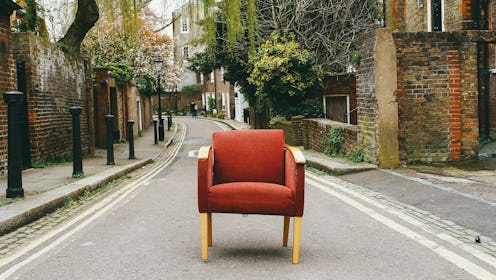Life
How To Buy Used Furniture You'll Actually Like

Not too long ago, I moved out of my college dorm and into the first apartment that didn't come pre-furnished with a school-issue desk and twin bed. This led to a dilemma: how was I going to fill my new room on a writer's salary? Sure, I had a few of the necessities for making that space livable: sheets and pillows, some plates, pictures in frames I'd bought on clearance over the years. But I didn't have a bed frame, or a mattress, or a desk, or a chair — and I had no idea how to buy used furniture for the essentials I needed. I scanned the price listings at local furniture stores, but that only made my heart sink. What if I bought something I needed right away, like that bed frame, and it didn't fit, or it was the wrong color, or it wobbled every time I turned over?
So I turned to Craigslist. I nabbed a $200 bed frame, which I'd been eyeing on a furniture store's website, for $100. A sizable corner desk meant another $80. If I'd bought these things new, I'd have paid over double what I actually forked out. I began to wonder: if I was going to keep buying secondhand furniture and appliances (and that was certainly the plan), what did I need to know?
That necessitated some research, but the following tips have definitely helped me dress up the space the way I've wanted to.
1. Don't just look on Craigslist
Sure, I got lucky that way. But if you're looking for something specific, like a powder-blue dining room table or a chair that's juuust the right dimensions, you might have to broaden your search. Most thrift stores, like Goodwill or the Habitat for Humanity store, have a wide range of pieces available for dirt cheap. What's more, if your city is anything like mine, it will have a host of mom-and-pop thrift and antique stores.
Beauty and Bedlam suggests also monitoring the local yard sale circuit. Yard sales often happen when people are moving or restructuring their living quarters, so they're eager to get rid of furniture they don't need any longer.
2. Embrace alterations
Maybe you've followed the previous tip and are prowling through the stacks of furniture at a yard sale nearby. You see the cutest end table that would work perfectly next to your bed, but the finish is scratched up, or maybe it's bright orange and you were looking for something a bit more... subdued. If you know it'll save you buckets of money to buy the used piece and paint over it, just give it a shot. You can do it yourself, or if that's not in the cards, take it to a professional. Dabney Frake of Apartment Therapy writes that she once saw a Chesterfield-style sofa going for $40, but she didn't like the fabric, so she bought it and had it reupholstered. She ended up with a gorgeous gray sofa that suited her space perfectly.
3. Check for structural flaws
If the table you're considering has a shaky leg you know you'd have to shim up in order to make the table surface flat, find something else. It'll save you more money in the long run. Likewise, look for cracked veneers, missing parts, and badly made repairs. If you're searching for something you'll sit on, like a love seat or a bar stool, actually sit on the thing to make sure it can hold your weight. Buying used furniture isn't like buying from the store: you'll have a much harder time returning it if you're not satisfied with what you get. This is why, says Jasmine Orchard of Jasmine Orchard Styling, seeing an item in person is always better.
4. Stick to your budget
As you're surfing Craigslist posts for a new desk, you might see something you absolutely adore — but that's $50 over the price you've set for yourself. Or maybe the desk you've discovered has a price you're comfortable paying, but the finish and paintbrushes you'll have to buy to complete the project will cost another $25. Don't make a habit of buying costly furniture just because you fall for it at first glance. If you evaluate all the pros and cons of going over-budget and decide it's worth it, then sure, go ahead. But keep in mind that furniture isn't like other impulse purchases. Buying a shirt on a whim isn't as hard to deal with as buying a heavy bookshelf on a whim.
5. Keep transportation in mind
Furniture can be a royal pain in the butt to move around. Many pieces weigh a ton, and others are shaped strangely, making those pieces difficult to fit through doors and around corners. When buying used, remember that transporting the item to your digs is a responsibility that often falls on you. If it's something large, like a bed frame you can't disassemble, you might have to hire professional movers to get that thing from Point A to Point B. And if you try to do it yourself, expect sweat, frustration, and lots of time down the drain.
If it's not ultimately worth it, look elsewhere.
Images: Eduard Militaru, Annie Spratt, Benjamin Child/Unsplash; terimakasi0, Unsplash, Calm/Pixabay; Unsplash/Pexels